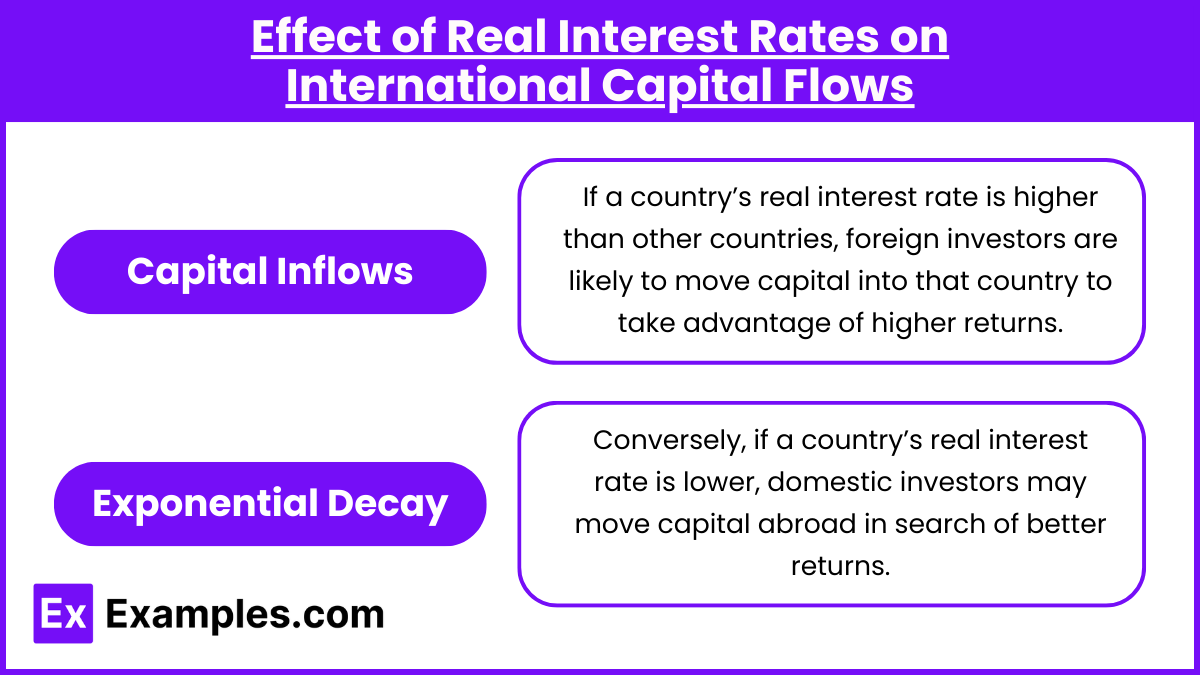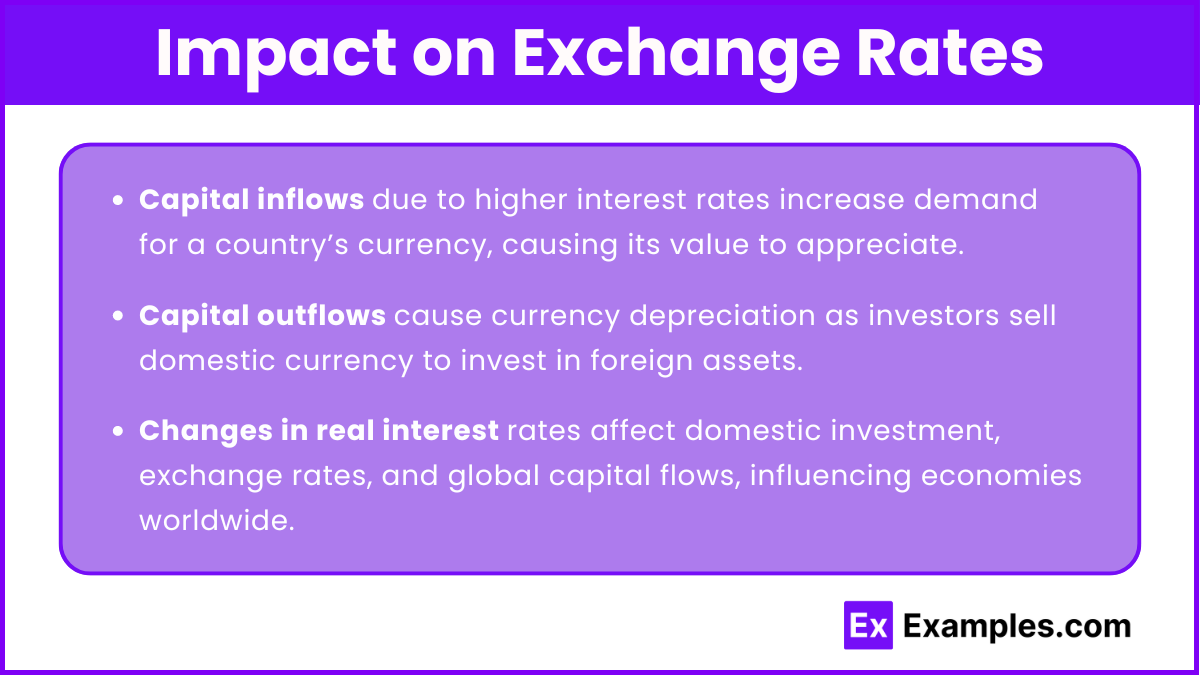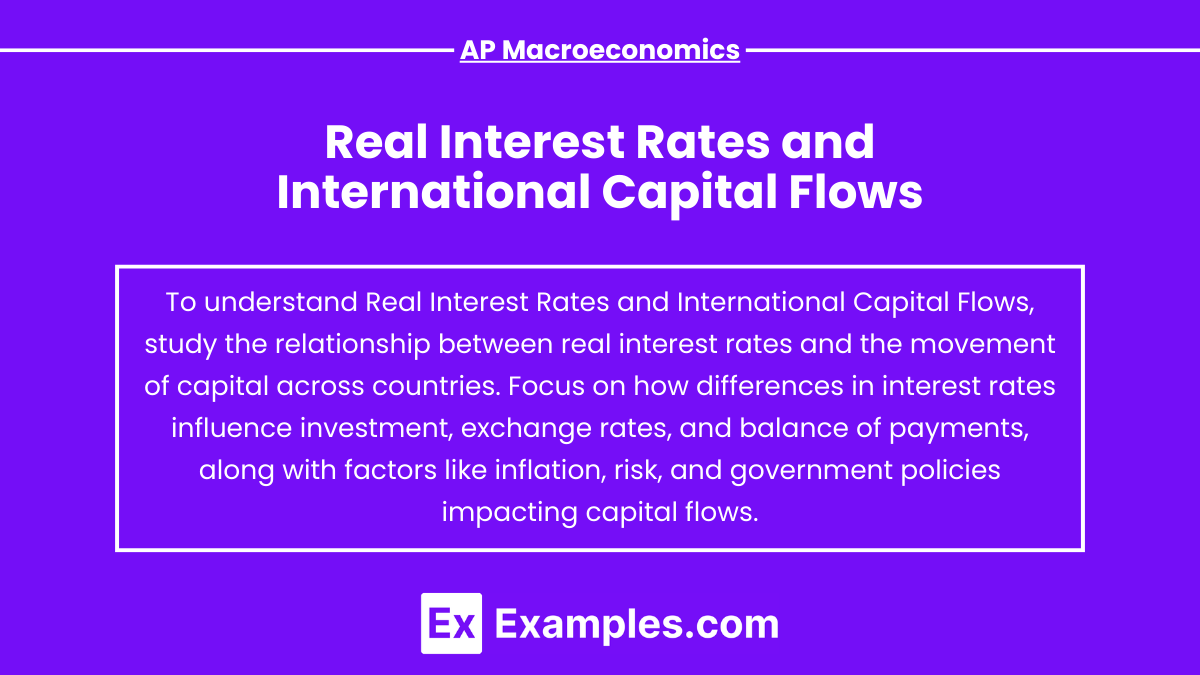Real interest rates, which adjust nominal interest rates for inflation, are a crucial factor in shaping international capital flows. In AP Macroeconomics, understanding the relationship between real interest rates and capital movement is essential for analyzing global economic dynamics. Higher real interest rates in one country attract foreign investment, leading to capital inflows, while lower real interest rates can result in capital outflows as investors seek better returns elsewhere. This interplay significantly impacts exchange rates, trade balances, and overall economic performance across nations.
Learning Objectives
For the topic “Real Interest Rates and International Capital Flows” in AP Macroeconomics, you should focus on understanding how real interest rates, adjusted for inflation, influence capital flows between countries. Learn how higher real interest rates attract foreign investment (capital inflows), while lower rates lead to capital outflows. Additionally, study the relationship between real interest rates, exchange rates, and currency valuation. Grasp the global impact of capital movements on trade balances, economic growth, and how shifts in interest rates affect global financial markets.
Real Interest Rates

The real interest rate is the nominal interest rate adjusted for inflation. It reflects the true cost of borrowing or the true return on investment.
![]()
Higher real interest rates make saving more attractive and borrowing more costly, while lower real interest rates encourage borrowing and investment.
Connection to International Capital Flows
- International capital flows refer to the movement of money for the purpose of investment, trade, or business production between countries.
- Real interest rates in one country compared to another can significantly influence international capital flows.
Effect of Real Interest Rates on International Capital Flows

- Capital Inflows:
- If a country’s real interest rate is higher than other countries, foreign investors are likely to move capital into that country to take advantage of higher returns.
- For example, if Country A has a higher real interest rate than Country B, investors from Country B will likely buy bonds, stocks, or other financial assets in Country A.
- This inflow increases the supply of loanable funds, which could lead to lower domestic interest rates over time.
- Capital Outflows:
- Conversely, if a country’s real interest rate is lower, domestic investors may move capital abroad in search of better returns.
- For example, if the real interest rate in Country B is lower than in Country A, investors in Country B may seek better returns by investing in Country A, leading to capital outflows from Country B.
Impact on Exchange Rates

- Capital flows are also closely tied to exchange rates. When capital flows into a country due to higher real interest rates, demand for that country’s currency increases, leading to currency appreciation.
- On the other hand, capital outflows can lead to depreciation of a country’s currency as investors sell off the domestic currency to invest in foreign assets.
- Changes in real interest rates can impact not only the domestic economy but also the global financial system.
- Countries with capital inflows may experience economic growth due to increased investment, while countries with outflows could face lower growth and a weaker currency.
Example:
- In a global context, the U.S. dollar often strengthens when U.S. real interest rates rise compared to other countries because international investors seek the higher returns available in the U.S. This can also impact trade, as a stronger dollar makes U.S. exports more expensive and imports cheaper.
Examples
Example 1 : U.S. Federal Reserve and Capital Inflows
In 2018, the U.S. Federal Reserve raised real interest rates to combat rising inflation and stabilize the economy. This higher real interest rate made U.S. financial assets more attractive to international investors, leading to significant capital inflows. Foreign investors bought U.S. government bonds and corporate securities, strengthening the U.S. dollar and increasing the demand for U.S. financial instruments. The influx of foreign capital provided more funding for investment in the U.S., boosting the economy.
Example 2 : European Central Bank and Capital Outflows
After the 2008 global financial crisis, the European Central Bank (ECB) kept real interest rates low in an effort to stimulate the European economy. However, these low rates led to capital outflows from Europe as investors sought higher returns elsewhere, particularly in emerging markets and the U.S., where real interest rates were relatively higher. The capital outflows weakened the euro and caused concerns about economic stagnation in some European countries.
Example 3: Japan’s Negative Interest Rates and Foreign Investment
In 2016, Japan implemented negative real interest rates to counter deflation and spur economic growth. This policy made domestic investments less appealing to both domestic and international investors. As a result, there was a large outflow of capital from Japan to countries with higher real interest rates, such as the U.S. and Australia. This capital flight weakened the yen and posed challenges for Japan’s financial markets, while boosting demand for foreign assets.
Example 4: Brazil’s High Interest Rates and Capital Inflows
In the early 2010s, Brazil maintained high real interest rates to control inflation and attract foreign capital. The high real interest rates drew significant foreign investment into Brazil’s bond market, contributing to a surge in capital inflows. This inflow strengthened the Brazilian real, but the country also experienced volatility in its currency and financial markets due to the influx of speculative capital, which sometimes quickly exited during periods of global financial uncertainty.
Example 5: Turkey’s High Inflation and Capital Flight
In recent years, Turkey experienced high inflation, which reduced the real interest rate despite nominal interest rates being relatively high. As inflation eroded returns, international investors began pulling capital out of Turkey, moving it to countries with more stable real interest rates. This capital flight contributed to the depreciation of the Turkish lira, further exacerbating inflation and economic instability in the country.
Multiple Choice Questions
Question 1
If Country A has a higher real interest rate than Country B, which of the following is the most likely outcome?
A) Capital will flow from Country A to Country B.
B) Capital will flow from Country B to Country A.
C) The value of Country A’s currency will depreciate.
D) The value of Country B’s currency will appreciate.
Answer: B) Capital will flow from Country B to Country A.
Explanation: When Country A has a higher real interest rate than Country B, investors in Country B will be attracted to the higher returns in Country A. This causes capital to flow from Country B to Country A. As investors exchange their currency for Country A’s currency, demand for Country A’s currency increases, which can lead to its appreciation, not depreciation as mentioned in option C. Option A is incorrect because the flow of capital would be toward the country offering higher returns, not the lower.
Question 2
An increase in real interest rates in a country typically leads to which of the following?
A) A decrease in foreign investment
B) An increase in capital inflows
C) Depreciation of the domestic currency
D) A decrease in demand for the domestic currency
Answer: B) An increase in capital inflows
Explanation: When real interest rates rise in a country, it becomes more attractive for foreign investors to move their capital into that country, as they can earn higher returns on investments. This results in an increase in capital inflows (B). Options A and D are incorrect because higher real interest rates typically increase, not decrease, demand for the domestic currency and foreign investment. Option C is incorrect because increased capital inflows typically cause the domestic currency to appreciate, not depreciate.
Question 3
Which of the following is a direct effect of a country experiencing capital outflows due to lower real interest rates?
A) The country’s currency appreciates.
B) The demand for the country’s currency increases.
C) The country’s currency depreciates.
D) There is an increase in foreign direct investment in the country.
Answer: C) The country’s currency depreciates.
Explanation: Capital outflows occur when investors seek better returns in other countries with higher real interest rates. As investors sell the domestic currency to purchase foreign assets, the demand for the domestic currency decreases, leading to depreciation (C). Option A is incorrect because the currency is more likely to depreciate rather than appreciate. Option B is incorrect because demand for the currency decreases with capital outflows, not increases. Option D is incorrect because foreign direct investment is likely to decrease, not increase, when real interest rates are lower and capital is flowing out of the country.


